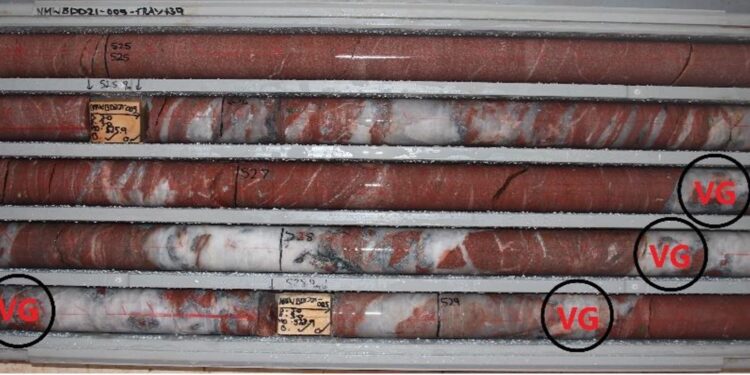Nexus Minerals Limited (ASX: NXM) has received high-grade assay results from four diamond tail / RC Precollar holes and one vertical reverse circulation (RC) hole drilled at the Crusader Prospect, within the Company’s Wallbrook gold project in the eastern goldfields of Western Australia.
Managing Director, Andy Tudor, said the broad high-grade gold results continue to impress and build the company’s confidence in the continuity of the high-grade gold mineralisation at Crusader.
“The visible gold seen in DDH#5 is very encouraging as it represents the first time we have logged visible gold in drilling at Crusader-Templar,” he said.
“The fact that the visible gold is logged in the middle of some 30m of intense alteration makes it even more significant.
“The alteration style and mineralisation observed in the Crusader-Templar drill holes exhibit the same style that hosts the multi-million ounce Karari deposit 30km to the south providing additional confidence in the potential pedigree of the project.
“The systematic and determined exploration approach by the Nexus team that has led to this discovery, is setting up the project for its success.”
Mr Tudor said that as more drilling is completed as part of the 30,000m RC programme currently underway and the density of drilling increases then internal characterisitcs to the mineralisation including internal plunge geometry to the mineralisation will mature.
The four diamond drill holes completed “tails” to RC pre-collars were drilled to test the mineralised zone at a depth of ~250m, with all four holes completed in this programme intersecting mineralisation.
The single vertical RC hole (#198) has successfully tested the vertical extent and tenor of mineralisation at the southern end of the Crusader mineralisation. The gold mineralisation tenor and widths observed to date are consistent with broad mineralisation in the shallower levels 100 meters (4m @ 6.23g/t Au, within 28m @ 1.44g/t Au from 108m).
Forward Exploration Programme
The 30,000m RC drill programme currently underway at Crusader-Templar will test for depth extensions to the mineralisation, down to approximately 250m below surface, as well as testing the full 1.6km strike of the Crusader-Templar mineralised corridor currently identified.
The full strike extent of the mineralisation is still to be tested and is constrained only by the extent of drilling completed by Nexus to date.
The deeper diamond drill holes DDH#2, DDH#4 and DDH#5 have all intersected and “tagged” the mineralised structure at depth. The 30,000m RC drill programme will complete drill holes on 40m line spacings and 40m along the lines.
To increase confidence in the mineralisation grade and continuity, some areas will have a more detailed 20m line spacing / 20m along the line spacing pattern. Gold mineralisation at the Crusader – Templar Prospect is hosted in the same rocks as those observed at the Karari Mine (Northern Star’s multi-million ounce mine 30km’s to the south), being a quartz-goethite supergene stockwork in the oxide regolith profile. The stockwork intensity correlates closely with higher gold grades. In the fresh rock, high-grade mineralisation occurs within a series of steeply dipping structures defined by quartz sulphide veining of altered quartz porphyry and volcaniclastic rock units. The cross section shown in Figure 4 is drawn through the centre of the Crusader Prospect (6,696,500mN). It incorporates all existing RC and/or diamond drill strings with assay results colour coded for downhole gold values.
All drill holes 400m either side of the cross- section line are included in the figure. The cross section shows a clear “pattern” of three distinct zones of mineralisation is emerging, being a horizontal oxide supergene zone and two steeply dipping primary hanging-wall and footwall lodes extending to depth.
For further information please visit: https://www.nexus-minerals.com/












